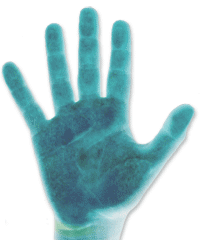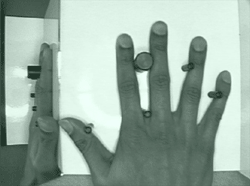
 Hand recognition uses the geometric shape of the hand for authenticating a user's identity. This method is an interesting approach, but individual hand features are not descriptive enough for identification. However, it is possible to devise a method by combining various individual features to attain robust verification. Hand recognition uses the geometric shape of the hand for authenticating a user's identity. This method is an interesting approach, but individual hand features are not descriptive enough for identification. However, it is possible to devise a method by combining various individual features to attain robust verification.
Hand geometry data is easier to collect; but unlike fingerprints, the human hand isn't quite as unique. One can use finger length, thickness, and curvature for the purposes of verification but not for identification. This technology is more suitable in situations where there are more users and are perhaps less disciplined in their approach to the system. With fingerprint acquisition, good frictional skin is required by imaging systems, and with retina-based recognition systems, special lighting is necessary. Hand geometry can be easily combined with other biometrics, namely the fingerprint, to enhance the identification authenticity. One can also devise a system where fingerprints are used for (infrequent) identification and hand geometry is used for (frequent) verification.
A typical popular example of hand geometry readers used in organizations is a time and attendance recording device. The ease of integration coupled with the ease of use makes hand geometry a good first step for many biometric projects.
 An example[1] of a hand scanner image acquisition system comprises of a light source, a camera, a single mirror and a flat surface (with five pegs on it). The user places his hand - palm facing downwards - on the flat surface of the device. The five pegs serve as control points for an appropriate placement of the right hand of the user. This device can also have knobs to change the intensity of the light source and the focal length of the camera. The mirror projects the side-view of the user's hand onto the camera. Feature extraction involves computing the widths and lengths of the fingers at various locations using the captured image. These metrics define the feature vector of the user's hand. An example[1] of a hand scanner image acquisition system comprises of a light source, a camera, a single mirror and a flat surface (with five pegs on it). The user places his hand - palm facing downwards - on the flat surface of the device. The five pegs serve as control points for an appropriate placement of the right hand of the user. This device can also have knobs to change the intensity of the light source and the focal length of the camera. The mirror projects the side-view of the user's hand onto the camera. Feature extraction involves computing the widths and lengths of the fingers at various locations using the captured image. These metrics define the feature vector of the user's hand.
Advantages
- Easy for end user to use.
- Hand geometry data is easy to collect.
- This form of biometric capture is non-invasive to the user.
Disadvantages
- The human hand geometry isn't quite as unique as other biometrics such as fingerprint.
- The False Acceptance Rate can be high compared to other techniques.
At BioVeriCom, Inc., we only provide hand geometry biometric technology for custom application development.
[1] A.K. Jain, A. Ross, and S. Pankanti, "A Protoype Hand Geometry-based Verification System", 2nd International Conference on Audio- and Video-based Biometric Person Authentication, Mar, 1999. Pp. 166-171.
|













 Hand recognition uses the geometric shape of the hand for authenticating a user's identity. This method is an interesting approach, but individual hand features are not descriptive enough for identification. However, it is possible to devise a method by combining various individual features to attain robust verification.
Hand recognition uses the geometric shape of the hand for authenticating a user's identity. This method is an interesting approach, but individual hand features are not descriptive enough for identification. However, it is possible to devise a method by combining various individual features to attain robust verification. An example[1] of a hand scanner image acquisition system comprises of a light source, a camera, a single mirror and a flat surface (with five pegs on it). The user places his hand - palm facing downwards - on the flat surface of the device. The five pegs serve as control points for an appropriate placement of the right hand of the user. This device can also have knobs to change the intensity of the light source and the focal length of the camera. The mirror projects the side-view of the user's hand onto the camera. Feature extraction involves computing the widths and lengths of the fingers at various locations using the captured image. These metrics define the feature vector of the user's hand.
An example[1] of a hand scanner image acquisition system comprises of a light source, a camera, a single mirror and a flat surface (with five pegs on it). The user places his hand - palm facing downwards - on the flat surface of the device. The five pegs serve as control points for an appropriate placement of the right hand of the user. This device can also have knobs to change the intensity of the light source and the focal length of the camera. The mirror projects the side-view of the user's hand onto the camera. Feature extraction involves computing the widths and lengths of the fingers at various locations using the captured image. These metrics define the feature vector of the user's hand.







